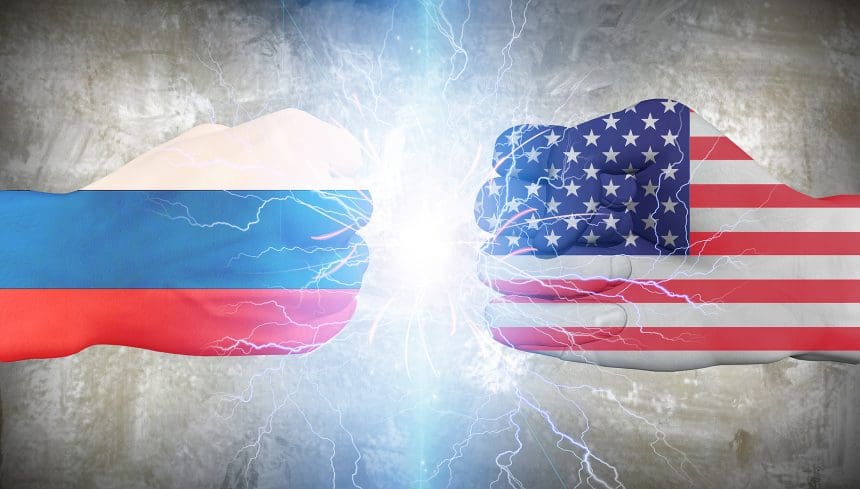The Rising Tensions Between the US and Russia: A Deep Dive into the Military and Geopolitical Landscape
(STL.News) The geopolitical rivalry between the United States (USA) and Russia has been intensifying over the past few decades, driven by a complex mix of historical conflicts, military posturing, and evolving global dynamics. The recent escalation, particularly following Russia’s invasion of Ukraine, has highlighted the deepening divide between the two nuclear powers. In this article, we will examine the key factors that have contributed to the current state of US-Russia relations, with a focus on military capabilities, historical context, and recent developments that continue to shape the geopolitical landscape. Additionally, we introduce a video that provides insight into America’s military capabilities, although we note that the content has not been independently verified, and we do not guarantee its accuracy.
Historical Context: NATO Expansion and Security Concerns
The seeds of tension between the USA and Russia can be traced back to the end of the Cold War. In the aftermath of the Soviet Union’s collapse, NATO, the US-led military alliance, began to expand eastward, incorporating former Soviet republics and Eastern European countries that were once part of the Soviet sphere of influence. While NATO argued that this expansion was aimed at promoting peace and democracy, Russia viewed it as a direct threat to its security.
During the 1990s, Western leaders assured Russia that NATO would not extend its reach beyond Germany. However, the inclusion of former Soviet republics, such as Estonia, Latvia, and Lithuania, along with other Eastern European countries, fueled Russia’s concerns. Moscow perceives this eastward expansion as a strategic encirclement and has repeatedly called for security guarantees from the West, a demand that remains unfulfilled. The tension surrounding NATO’s expansion was further exacerbated by the United States’ withdrawal from several arms control agreements, including the 2002 decision to leave the Anti-Ballistic Missile (ABM) Treaty. These developments set the stage for a growing rift between the two powers.
The Ukraine Conflict: A Turning Point
One of the most significant flashpoints in the USA-Russia rivalry occurred in 2014, when Russia annexed Crimea following Ukraine’s 2014 Euromaidan Revolution. This marked a major shift in Russia’s foreign policy and signaled the beginning of an ongoing conflict in eastern Ukraine. The international community widely condemned the annexation, and the US and European Union imposed sanctions on Russia in response.
In 2022, the situation escalated further when Russia launched a full-scale invasion of Ukraine. President Vladimir Putin justified the invasion as a necessity to protect Russian-speaking populations in Ukraine and to counter NATO’s perceived encroachment on Russia’s borders. The West, led by the USA, responded by providing Ukraine with extensive military aid, including advanced weapons systems and intelligence support. The conflict has since become a proxy war between the U.S. and Russia, with the potential for global ramifications.
The invasion of Ukraine also led to the suspension of the New START treaty, the last remaining arms control agreement between the US and Russia. This treaty, which was signed in 2010, limited the number of deployed strategic nuclear warheads and missiles for both nations. The suspension of this agreement has raised concerns about a renewed arms race and a further deterioration in diplomatic relations.
The Erosion of Arms Control Treaties
Another significant factor contributing to rising tensions between the US and Russia is the collapse of key arms control frameworks. For decades, agreements like the INF Treaty (Intermediate-Range Nuclear Forces Treaty) and the ABM Treaty helped to limit the development and deployment of certain types of weapons, thereby reducing the risk of nuclear conflict.
However, in recent years, both the US and Russia have withdrawn from these important treaties. In 2019, the USA formally withdrew from the INF Treaty, accusing Russia of violating the terms by deploying new missile systems. Russia responded by suspending its participation in the treaty. Similarly, the US has expressed concerns over Russia’s compliance with the New START treaty, particularly regarding the modernization of its nuclear arsenal.
The collapse of these arms control agreements has created a dangerous environment in which both nations are free to develop and deploy advanced weapons systems without significant limitations. This has increased the risk of misunderstandings and miscalculations that could escalate into open conflict.
The Military Balance: A New Arms Race?
The growing military rivalry between the USA and Russia is evident in the development of new weapons systems, the expansion of military budgets, and the strategic positioning of forces worldwide. Both countries have significantly modernized their nuclear arsenals, with Russia developing new hypersonic missiles and the USA investing in advanced missile defense systems.
The United States remains the world’s leading military spender, with an annual defense budget exceeding $700 billion. This budget supports a vast array of military technologies, including state-of-the-art fighter jets, advanced missile systems, and a robust nuclear arsenal. The USA also maintains a global military presence, with bases in Europe, Asia, and the Middle East, further consolidating its strategic advantage.
Russia, on the other hand, has focused on strengthening its regional military influence. Despite having a smaller defense budget than the USA, Russia has invested heavily in modernizing its nuclear and conventional forces. Moscow’s military capabilities are often framed in terms of its nuclear deterrent, which remains one of the largest in the world. Russia has also been increasing its military presence in the Arctic and other strategically important regions.
Both nations are now engaged in an arms race of sorts, with each striving to develop more advanced weapons systems that could give them a strategic advantage in the event of conflict. This arms race, coupled with the erosion of arms control agreements, has led many experts to warn that we are on the brink of a new Cold War.
Introducing the Video: A Look at U.S. Military Strength
In light of the ongoing tensions between the US and Russia, understanding the military capabilities of the U.S. is crucial to grasping the potential consequences of any further escalation. A recent video offers insight into the strength of America’s military, showcasing its advanced technologies and capabilities.
This video offers a comprehensive overview of the US military’s arsenal, encompassing its nuclear and conventional forces. While we do not guarantee the accuracy of the video’s content—since it has not been independently verified—it serves as a valuable resource for gaining a deeper understanding of the scope of America’s military might. From nuclear submarines to advanced missile defense systems, the video highlights the significant technological advantages that the U.S. holds over its adversaries.
However, it is important to approach the video’s information with caution. As with any resource, viewers should cross-reference the details presented with other credible sources for a comprehensive understanding of the topic. The video serves as a starting point for exploring the complex military dynamics between the US and Russia.
Conclusion: Navigating the Future of US-Russia Relations
The escalating tensions between the United States and Russia are the result of a combination of factors, including NATO’s expansion, Russia’s annexation of Crimea, and the collapse of arms control treaties. Both countries continue to invest heavily in their military capabilities, raising concerns about a potential arms race and the risk of conflict.
As the US and Russia position themselves as global superpowers, the need for diplomatic engagement and renewed arms control agreements has never been more urgent. While military strength plays a key role in shaping global geopolitics, diplomacy remains the most effective tool for ensuring peace and stability in a rapidly changing world. Understanding the complex dynamics between the U.S. and Russia is essential for navigating the future of international relations.
The video referenced in this article offers additional insights into the capabilities of the U.S. military; however, viewers should approach the content with a critical eye and verify the information independently. As we move forward, it is clear that the actions of both the U.S. and Russia will have a profound impact on the geopolitical landscape for years to come.
© 2025 STL.News/St. Louis Media, LLC. All Rights Reserved. Content may not be republished or redistributed without express written approval. Portions of our content may be created with the assistance of AI technologies, like Gemini or ChatGPT, and are reviewed by our human editorial team. For the latest news, head to STL.News.






